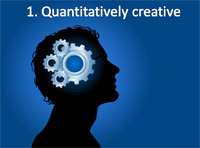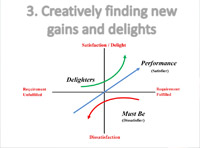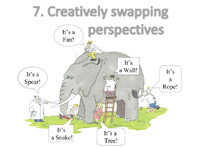By: Bengt Järrehult
When faced with the question “Are you creative?” I have found that only the half of the audiences I speak to consider themselves creative. This is true even when you talk to people that are supposed to be creative in developing products or market plans. As innovation is partly depending on guts to dare, something that comes from self-confidence, I think it is time that we stretch our old opinion on what creativity is all about – here are 7 different ways to be creative. I am sure you can find yourself described at least in a couple of them.
My fellow bloggers, Leif Denti (in Top six components of a creative climate) and Susanna Bill (in Can Catering for Creativity Make Innovation Happen) have brought up the close connection between creativity and innovation, but as Innovation is applied and used creatively we need to broaden the notion of creativity.
 1. The creative skills we usually think of when we refer to somebody as being creative is the ability to come up with lots of ideas in a short time in brain-storming sessions. This is referred to as being quantitatively creative. Most of the ideas do not stand up to scrutiny, which is okay, because finding a few is all that it takes for success.
1. The creative skills we usually think of when we refer to somebody as being creative is the ability to come up with lots of ideas in a short time in brain-storming sessions. This is referred to as being quantitatively creative. Most of the ideas do not stand up to scrutiny, which is okay, because finding a few is all that it takes for success.
 2. You all know the phrase “standing on the shoulders of a giant” and the giant can be seen as all the old ideas that are already available. There are people that are fantastic in putting already existing ideas together into new combinations, bundled together of already existing pieces. Just think of Apollo 13! This is what I call finding creative combinations.
2. You all know the phrase “standing on the shoulders of a giant” and the giant can be seen as all the old ideas that are already available. There are people that are fantastic in putting already existing ideas together into new combinations, bundled together of already existing pieces. Just think of Apollo 13! This is what I call finding creative combinations.
 3. One of the best way to get an invention adopted is to creatively find new gains and delights, often hidden and unexpressed, that make the difference as long as the basic jobs-to-be done are satisfied. This is very well expressed in the Kano diagram, (expressed well by Keith Goffin et al in the book Identifying hidden needs) and by Alexander Osterwalder in complement to the Business Model Canvas, the Value Proposition Designer Canvas. I think we are too focused on solving problems. Do not be so focused on the negatives. Go for the positives instead!
3. One of the best way to get an invention adopted is to creatively find new gains and delights, often hidden and unexpressed, that make the difference as long as the basic jobs-to-be done are satisfied. This is very well expressed in the Kano diagram, (expressed well by Keith Goffin et al in the book Identifying hidden needs) and by Alexander Osterwalder in complement to the Business Model Canvas, the Value Proposition Designer Canvas. I think we are too focused on solving problems. Do not be so focused on the negatives. Go for the positives instead!
 4. Most of you may have found a fantastically funny, odd and crazy idea – however its use may be unclear. When you think of breakthrough ideas in the innovation history, they’re usually spin-offs to what they were really looking for. To find the usage for this new idea demands a creative skill that I call creative exploitation.
4. Most of you may have found a fantastically funny, odd and crazy idea – however its use may be unclear. When you think of breakthrough ideas in the innovation history, they’re usually spin-offs to what they were really looking for. To find the usage for this new idea demands a creative skill that I call creative exploitation.
 5. Thomas Edison once claimed that genius is 1 % inspiration and 99 % perspiration, meaning that it is vital to make something out of your idea – otherwise it is worthless. This demands creative refinement of the idea you have from the back of the napkin to something providing value on the market.
5. Thomas Edison once claimed that genius is 1 % inspiration and 99 % perspiration, meaning that it is vital to make something out of your idea – otherwise it is worthless. This demands creative refinement of the idea you have from the back of the napkin to something providing value on the market.
 6. The 6th way to be creative I refer to as the skills of knowing where you are in your creativity. Dave Snowden has explained this very elegantly in his “Ontology view” on Youtube if you search for Cynefin. There are different levels of creative solutions needed – and accepted – depending on if you are in the simple world, complicated, complex or chaotic. Usually the largest need for creativity is in the last two worlds. Here you need Creative focus finding to know where you are and act accordingly.
6. The 6th way to be creative I refer to as the skills of knowing where you are in your creativity. Dave Snowden has explained this very elegantly in his “Ontology view” on Youtube if you search for Cynefin. There are different levels of creative solutions needed – and accepted – depending on if you are in the simple world, complicated, complex or chaotic. Usually the largest need for creativity is in the last two worlds. Here you need Creative focus finding to know where you are and act accordingly.
 7. Man is usually pleased with the 1st solution he/she finds and starts to develop this idea – but how do you know this is the best solution? By consciously and creatively swapping perspectives even though you find yourself comfortable with the first perspective you found. To break out of the first – and maybe good-enough solution – is not easy. If you can do that – I think you are truly creative!
7. Man is usually pleased with the 1st solution he/she finds and starts to develop this idea – but how do you know this is the best solution? By consciously and creatively swapping perspectives even though you find yourself comfortable with the first perspective you found. To break out of the first – and maybe good-enough solution – is not easy. If you can do that – I think you are truly creative!
Now – do you realize that you may be more creative than what you earlier thought?
By Bengt Järrehult
» Download a PowerPoint Presentation for this blog!
About the author
 Bengt Järrehult is Fellow Scientist Innovation at SCA, a global hygiene products and paper company. He is also adjunct professor and visiting professor resp. at 2 departments of Lund University in Sweden. He is an avid reader of and presenter on the topics of innovation, especially on breakthrough innovation and the psychological hurdles that exist to achieve this, hurdles that we may or may not be aware of. He is of the opinion that most companies more or less know what to do to become more innovative. What they don’t know is what really hinders them from doing these measures…
Bengt Järrehult is Fellow Scientist Innovation at SCA, a global hygiene products and paper company. He is also adjunct professor and visiting professor resp. at 2 departments of Lund University in Sweden. He is an avid reader of and presenter on the topics of innovation, especially on breakthrough innovation and the psychological hurdles that exist to achieve this, hurdles that we may or may not be aware of. He is of the opinion that most companies more or less know what to do to become more innovative. What they don’t know is what really hinders them from doing these measures…
